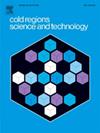改进季节性积雪地区地温预报的数值模拟
IF 3.8
2区 工程技术
Q1 ENGINEERING, CIVIL
引用次数: 0
摘要
在许多科学和工程应用中,预测季节性积雪地区每小时的土壤温度变化是必不可少的。然而,现有的积雪与土壤表面热相互作用模型主要基于经验相关性,导致预报仅限于日平均值。本文提出了一种改进逐时空间土壤温度预测的新方法,即在积雪期SS能量平衡方程中加入对数雪深项。所提出的方法已通过类似气候条件下长达一年的实验土壤温度测量得到验证。此外,还探讨了均质、各向同性和空间非均质土壤介质对土壤温度分布的影响。利用具有能量平衡的瞬态热传导方程的有限体积数值解模拟了土壤温度的时空预测。该方法在考虑土壤热扩散系数的情况下,在土壤深度为0.1、0.2、0.5、1、2和5 m时,其决定系数分别为0.958、0.983、0.989、0.994、0.964和0.888,与实验结果具有良好的一致性。此外,还确定了研究地点的日、季节土壤温度变化深度以及Kusuda和Achenbach相关常数。本文章由计算机程序翻译,如有差异,请以英文原文为准。
Numerical modelling for improved prediction of ground temperature in seasonal snow-cover regions
Predicting hourly soil temperature variation in seasonal snow cover regions is essential in many scientific and engineering applications. However, the existing snow and soil surface (SS) heat interaction models are predominantly based on empirical correlations, resulting in forecasts restricted to daily average values. Herein, a novel approach is presented to improve hourly spatial soil temperature prediction by incorporating a logarithmic snow depth term into the SS energy balance equation during the snow-covered periods. The proposed approach has been validated using year-long experimental soil temperature measurements from similar climatic condition. Further, the effect of homogenous, isotropic, and spatially heterogeneous soil media on soil temperature distribution has also been explored. The spatial and temporal soil temperature predictions are simulated using a finite-volume numerical solution of the transient heat conduction equation with energy balance at SS. The proposed approach, combined with consideration of spatially variable soil thermal diffusivity, exhibited excellent concordance with the experimental measurements, with coefficient of determination value of 0.958, 0.983, 0.989, 0.994, 0.964, and 0.888 at soil depths of 0.1, 0.2, 0.5, 1, 2, and 5 m, respectively. Additionally, the depth of daily and seasonal soil temperature variations and the Kusuda and Achenbach correlation constants for the study location have been determined.
求助全文
通过发布文献求助,成功后即可免费获取论文全文。
去求助
来源期刊

Cold Regions Science and Technology
工程技术-地球科学综合
CiteScore
7.40
自引率
12.20%
发文量
209
审稿时长
4.9 months
期刊介绍:
Cold Regions Science and Technology is an international journal dealing with the science and technical problems of cold environments in both the polar regions and more temperate locations. It includes fundamental aspects of cryospheric sciences which have applications for cold regions problems as well as engineering topics which relate to the cryosphere.
Emphasis is given to applied science with broad coverage of the physical and mechanical aspects of ice (including glaciers and sea ice), snow and snow avalanches, ice-water systems, ice-bonded soils and permafrost.
Relevant aspects of Earth science, materials science, offshore and river ice engineering are also of primary interest. These include icing of ships and structures as well as trafficability in cold environments. Technological advances for cold regions in research, development, and engineering practice are relevant to the journal. Theoretical papers must include a detailed discussion of the potential application of the theory to address cold regions problems. The journal serves a wide range of specialists, providing a medium for interdisciplinary communication and a convenient source of reference.
 求助内容:
求助内容: 应助结果提醒方式:
应助结果提醒方式:


